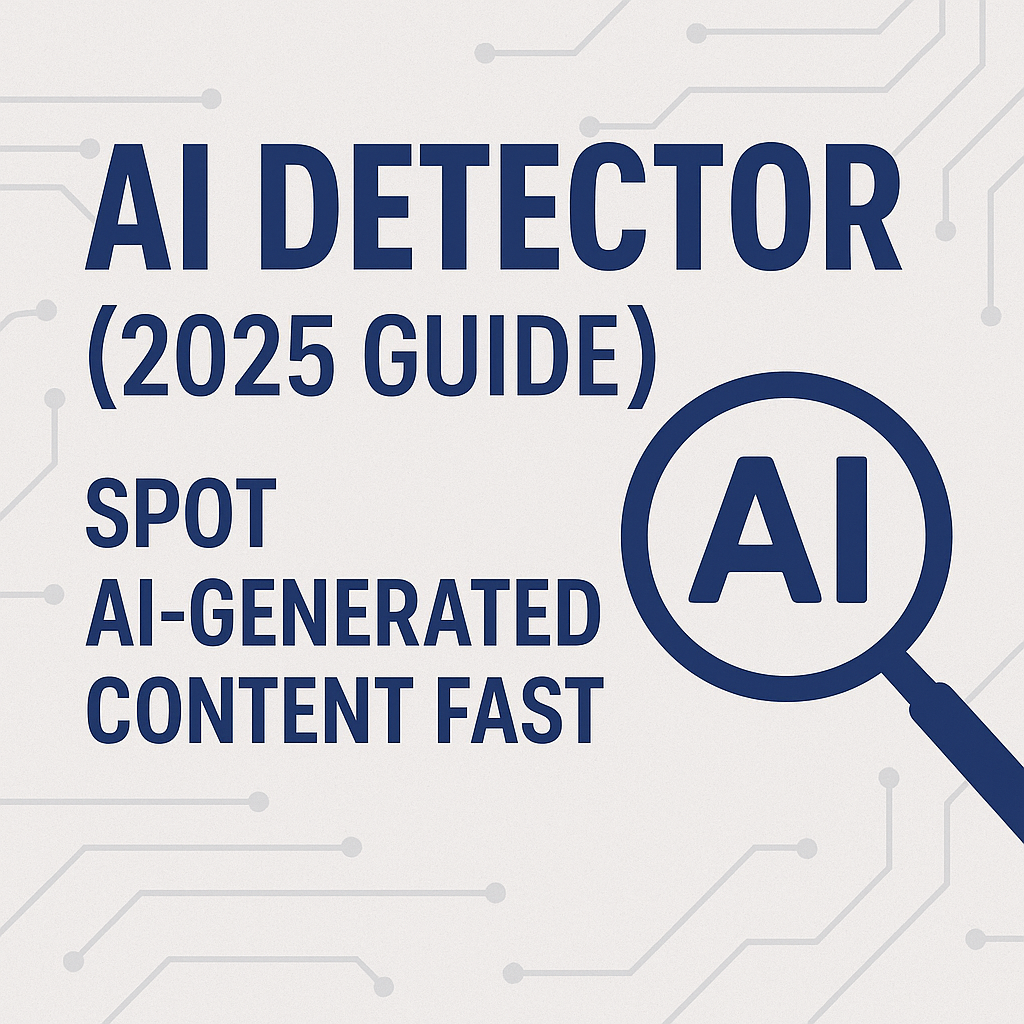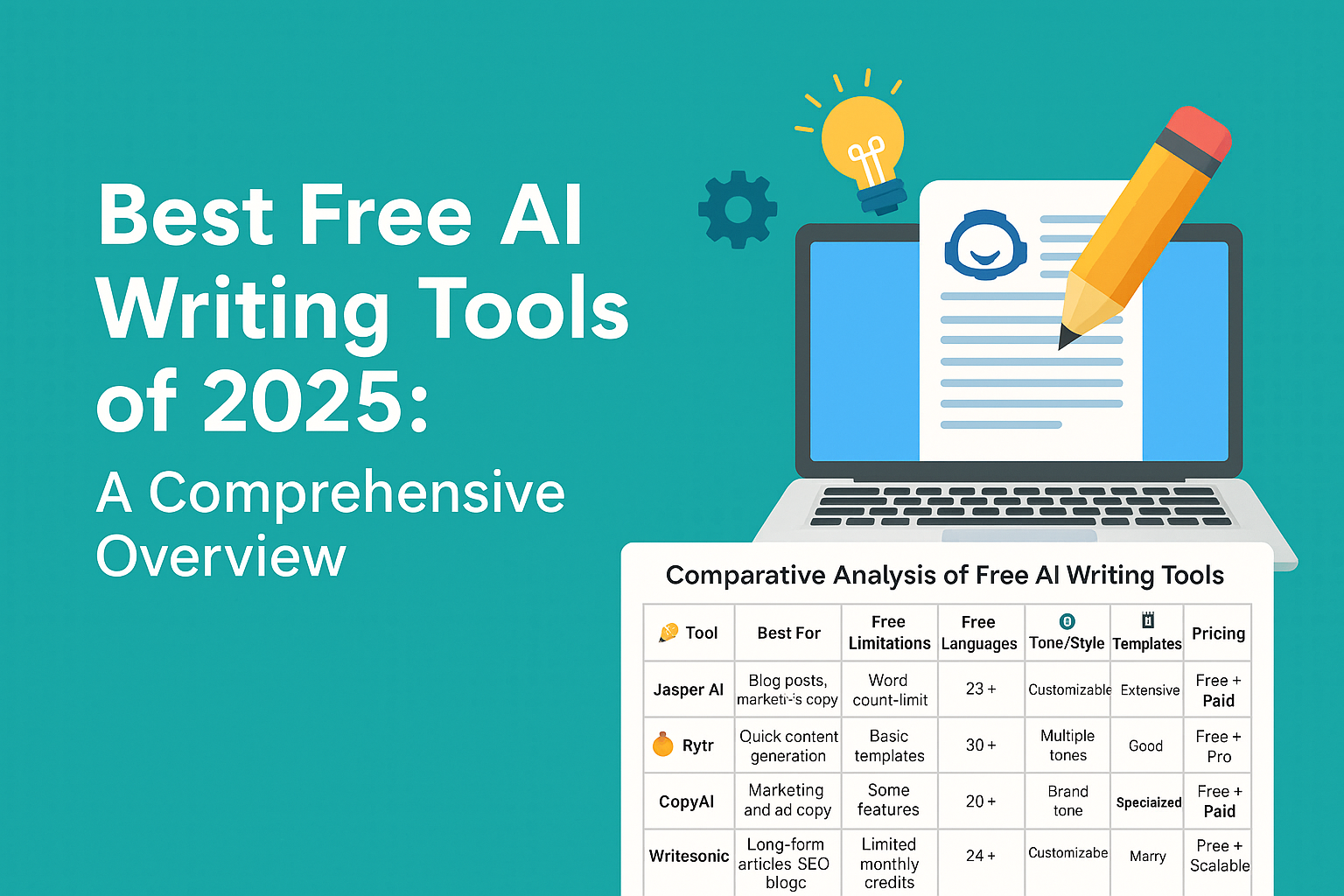AI Detector Technology: How It Works and Why It Matters
Understanding AI Detector Technology
AI detectors are becoming more important in our digital world. These tools can spot content created by artificial intelligence rather than humans. Think of them as digital bloodhounds that sniff out computer-generated text, images, or videos.

Visual guide to how AI detectors work in 2025
You might wonder how these tools work. AI detectors analyze patterns in content that humans typically don’t notice. They look at word choices, sentence structure, and how ideas flow together. AI-generated content often has certain “fingerprints” that these detectors can find.
Most AI detectors give you a percentage score showing how likely something came from AI. A high score means the content probably came from tools like ChatGPT or DALL-E, while a low score suggests human creation.
How AI Detectors Work
AI detectors use smart technology to spot computer-generated content. They work by:
- Analyzing writing patterns and word usage
- Looking for repetitive phrases or unusual consistency
- Checking how natural or mechanical the content sounds
- Examining the predictability of sentence structures
These tools have studied millions of examples of both human and AI writing. This helps them tell the difference between a person writing an email and ChatGPT drafting one.
Want to test your content? Try Content at Scale’s AI Content Detector.
Statistical Analysis Methods
One key approach involves statistics. AI writing often shows patterns that human writing doesn’t. For example, AI might use certain words at a more consistent rate. Human writers show more variety and unpredictability in their choices.
The detector looks at how often certain words appear and in what order. It checks if the pattern matches known AI writing styles. This is similar to how spam filters check emails.
Machine Learning Techniques
Many AI detectors use machine learning themselves. They’ve been trained on large datasets of both human and AI-created content. This helps them get better at spotting the differences over time.
These systems learn from their mistakes and improve with each piece of content they analyze. The more they see, the better they get at detection.
Why AI Detection Matters Today
You might be thinking, “Why should I care about AI detection?”
Want to understand what AI writing tools detectors are analyzing? Check out our guide to the best free AI writing tools.
The answer affects many parts of our lives:
Academic Integrity
Schools and colleges are using AI detectors to make sure students do their own work. With tools like ChatGPT making it easy to generate essays, teachers need ways to check if assignments are original.
Students who rely too much on AI might miss important learning opportunities. AI detectors help maintain educational standards and ensure fair grading.
Content Authenticity
When you read news or information online, you want to know a real person wrote it. AI detectors help identify when content comes from machines instead of journalists or experts.
This matters because AI can spread misinformation or create fake content that looks real. Detecting AI helps you trust what you’re reading.
Interested in detecting visual AI content too? Read our Midjourney prompt guide.
Job Market Protection
Writers, artists, and other creative professionals worry about AI replacing their work. AI detectors can help identify truly human-created content, which many people still value more highly.
These tools can also help employers verify that job applicants’ work samples are their own creation, not generated by AI.
Limitations of Current AI Detectors
AI detectors aren’t perfect. They sometimes make mistakes by:
- Flagging human content as AI-generated (false positives)
- Missing sophisticated AI content (false negatives)
- Struggling with content that mixes human and AI input
- Having trouble with non-English content
The technology is still developing. As AI writing tools get better, detectors must improve too. It’s like a digital arms race between creation and detection.
Read OpenAI’s announcement on their AI content classifier here.
The Future of AI Detection
AI detection technology is getting smarter every day. Future detectors will likely:
- Work across more languages and content types
- Detect subtle AI influences in mostly human work
- Provide more detailed analysis of content origins
- Become standard tools in schools and workplaces
You might soon see AI detection built into word processors, email programs, and social media platforms. This could help maintain transparency about who—or what—created the content you consume.
As AI becomes more common in our daily lives, knowing when you’re interacting with machine-generated content will only become more important. The line between human and AI creation continues to blur, making detection tools increasingly valuable for maintaining trust in digital communication.
The Evolution of AI Detection Tools in Digital Content
How AI Detectors Have Transformed Digital Content Verification
In recent years, the line between human and artificial intelligence-created content has blurred significantly. AI detectors have emerged as essential tools in this new digital landscape, helping to identify machine-generated text across websites, academic papers, and professional communications.
The first wave of AI detectors appeared around 2019, offering basic analysis capabilities that looked for patterns typical of early AI writing. These tools were relatively simple, focusing on repetitive phrases and unnatural sentence structures that were common in AI-generated content at that time.
As language models became more sophisticated, so did the detection technology. Modern AI detectors now examine multiple layers of text, looking beyond simple patterns to analyze contextual relevance, creative elements, and semantic consistency that often differentiate human writing from its AI counterpart.
Current Capabilities of AI Detection Tools
Today’s AI detectors employ various techniques to identify computer-generated content:
- Statistical analysis of sentence variation and complexity
- Evaluation of logical flow between paragraphs
- Assessment of creative language use and metaphors
- Detection of natural language inconsistencies
- Identification of common AI writing patterns
Most detection tools now provide a probability score rather than a simple yes/no answer, acknowledging the increasingly blurry line between human and AI writing. This nuanced approach helps users make informed decisions about the content they’re evaluating.
Real-World Applications
Educational institutions have become major adopters of AI detection technology. Teachers use these tools to ensure academic integrity as students gain access to increasingly powerful writing assistants. Many universities now incorporate AI detectors into their standard plagiarism-checking processes.
Publishers and content platforms also rely on AI detectors to maintain quality standards. News organizations use detection tools to verify that submitted content meets their authenticity guidelines, while some online platforms automatically scan user-generated content for AI signatures.
Want to speed up your workflow? Explore 5 AI automation tools that save hours every week.
Accuracy Challenges and Limitations
Despite their sophistication, AI detectors aren’t perfect. False positives remain a significant issue, with some human writers mistakenly flagged as using AI due to their structured writing style. Conversely, advanced AI systems can sometimes evade detection, especially when content has been carefully edited or “humanized” after generation.
Environmental factors also affect detection accuracy. The specific AI model used, the subject matter, and the length of the text all influence how reliably a detector can identify AI-generated content. Shorter texts typically pose greater challenges for accurate detection.
Detection Accuracy Variables
| Factor | Impact on Detection Accuracy |
|---|---|
| Text Length | Longer content provides more linguistic patterns for accurate analysis |
| Subject Complexity | Technical or specialized topics may reveal clearer AI writing traits |
| Human Editing | Manual edits can hide or reduce typical AI patterns |
| AI Model Type | Different AI models leave different linguistic fingerprints |
The Ethics of AI Detection
The growing use of AI detectors raises important ethical questions. When used in educational settings, these tools can help maintain academic integrity, but they also risk penalizing students who naturally write in ways that algorithms flag as machine-like.
In professional contexts, AI detection might create unfair barriers for writers who legitimately use AI assistance for tasks like grammar checking or brainstorming. This has led to ongoing discussions about where to draw the line between acceptable AI assistance and problematic AI replacement of human work.
Future Developments
AI detection technology continues to evolve rapidly. Researchers are developing more sophisticated approaches that look at deeper linguistic patterns and even subtle stylistic elements that currently help human writing stand apart from AI-generated text.
Some experts predict a potential “arms race” between detection tools and ever-more-convincing AI writing systems. This technological back-and-forth will likely drive innovations on both sides, with detectors becoming more nuanced and AI writing becoming more humanlike.
Watermarking technologies are also emerging as a promising solution. These systems embed invisible markers into AI-generated text, making detection more reliable without changing how the content appears to readers.
As digital content creation continues to evolve, AI detectors will remain vital tools for maintaining authenticity, credibility, and transparency in our increasingly AI-influenced information ecosystem. The challenge will be balancing effective detection with fair treatment of content creators who use AI responsibly as part of their workflow.
Key Features to Look for in Effective AI Detectors
Understanding AI Detection Technology
In today’s digital landscape, AI detectors have become essential tools for identifying content created by artificial intelligence. These sophisticated systems help users distinguish between human-written and AI-generated text, which is increasingly important as AI writing tools become more advanced.
When searching for an effective AI detector, accuracy should be your top priority. The best tools can identify subtle patterns and linguistic markers that reveal AI authorship. They analyze text structure, vocabulary usage, and sentence flow to make determinations about content origin.
Many quality AI detectors offer percentage-based results rather than simple yes/no answers. This nuanced approach provides a confidence score indicating how likely the content was created by AI. Look for detectors that offer this granular information to make better-informed decisions.
Essential Accuracy Features
False positive rates are crucial metrics when evaluating AI detectors. A good system minimizes instances where human-written content is incorrectly flagged as AI-generated. This balance ensures legitimate content isn’t unfairly penalized.
Training data diversity significantly impacts detector performance. Tools trained on varied content types perform better across different writing styles and subjects. Before choosing a detector, verify it has been exposed to diverse text samples during development.
Regular updates keep AI detectors current with evolving AI writing technologies. As language models advance, detection tools must adapt to recognize new patterns. Choose solutions with consistent update schedules and responsive development teams.
User Experience Considerations
An intuitive interface makes AI detection accessible to users with varying technical backgrounds. Clean design, straightforward controls, and clear results presentation are hallmarks of user-friendly detectors. Avoid overly complex systems that require technical expertise to interpret results.
Batch processing capabilities allow users to analyze multiple documents simultaneously. This feature saves significant time when checking numerous content pieces. For content managers and educators handling large volumes of text, this functionality is particularly valuable.
Integration options with popular platforms extend an AI detector’s utility. Look for tools that work seamlessly with content management systems, learning management systems, or word processors. These integrations streamline workflows by embedding detection directly into existing processes.
Privacy and Security Elements
Content security should be non-negotiable when selecting an AI detector. Quality tools process text without storing it permanently or using it to train their systems. Before committing to a service, review their privacy policy carefully to understand how your content is handled.
Local processing options provide additional security for sensitive information. Some detectors can operate entirely on your device without sending data to external servers. This approach eliminates transmission risks and keeps confidential content within your control.
GDPR and data protection compliance indicates a detector service takes privacy seriously. Reputable providers clearly state their adherence to relevant regulations and implement appropriate safeguards for user data.
Practical Analysis Features
Detailed feedback mechanisms help users understand why content was flagged as AI-generated. Look for detectors that highlight specific text passages and explain detection patterns. This transparency builds trust and provides educational value about AI writing characteristics.
| Feature | Importance | Impact on Detection |
|---|---|---|
| Confidence Scoring | High | Provides nuanced assessment rather than binary judgment |
| False Positive Control | Critical | Prevents legitimate content from being wrongly flagged |
| Training Data Diversity | High | Ensures accurate detection across content types |
| Regular Updates | Essential | Maintains effectiveness against evolving AI models |
Cross-referencing capabilities compare results against multiple detection algorithms. This approach reduces reliance on a single method and improves overall accuracy. The best tools employ several detection techniques and consolidate findings for more reliable results.
Language support variety determines which content you can effectively analyze. Premium detectors recognize multiple languages and maintain consistent accuracy across them. If you work with multilingual content, verify the detector supports all required languages before purchasing.
Remember that no AI detector is perfect. Even the most advanced tools occasionally make mistakes. The key is finding a solution that balances accuracy, usability, and privacy while meeting your specific content verification needs. By focusing on these essential features, you can select an AI detector that provides reliable results and integrates smoothly into your content workflow.
Limitations and Challenges of Current AI Detection Methods
The Evolving Landscape of AI Detection Technology
While AI detectors have become increasingly sophisticated, they face significant hurdles that limit their effectiveness. These tools, designed to distinguish between human and AI-generated content, operate in a rapidly evolving technological environment where both detection and evasion techniques continuously advance.
Current detection methods primarily rely on statistical patterns and linguistic markers that AI systems tend to produce. However, these approaches often struggle with nuanced content and can be fooled by simple modifications. Many detectors analyze text predictability, vocabulary distribution, and sentence structure to make determinations, yet these parameters aren’t always reliable indicators.
Accuracy and False Positive Concerns
One of the most pressing challenges for AI detectors is the high rate of false positives. Many legitimate human writers have experienced the frustration of having their original work flagged as AI-generated. This occurs because certain writing styles naturally align with patterns that detectors associate with AI output.
Technical writers, academics, and professionals who write in standardized formats are particularly vulnerable to false identification. Their structured, formal language often triggers AI detection algorithms despite being completely human-sourced. This undermines trust in detection systems and creates unnecessary obstacles for content creators.
Model-Specific Limitations
Most detection tools are optimized to identify content from specific AI models they were trained to recognize. When confronted with output from newer or less common AI systems, their accuracy drops significantly. This creates a constant cat-and-mouse game where detection tools must continuously update to keep pace with emerging AI writing technologies.
See this technical research on GPT detection from arXiv.org.
The effectiveness of detectors also varies dramatically across languages. While most perform reasonably well with English content, their reliability decreases substantially when analyzing text in other languages, especially those with non-Latin scripts or complex grammatical structures.
The Paraphrasing Problem
Simple paraphrasing techniques can often bypass even sophisticated AI detectors. When AI-generated text is lightly edited by humans or run through paraphrasing tools, most detection systems struggle to identify the content’s origin accurately. This hybrid approach creates text that contains AI foundations but with enough human-like variations to evade detection.
Content that mixes AI and human input presents a particularly difficult challenge. As collaborative writing processes become more common, with humans editing, expanding, and refining AI-generated drafts, the line between human and machine authorship grows increasingly blurred. Most current detectors lack the nuance to properly evaluate such mixed-source content.
Technical Implementation Challenges
Detection systems face practical implementation hurdles as well. Processing lengthy documents requires significant computational resources, making real-time detection difficult for large volumes of content. This creates scalability problems for platforms that need to analyze substantial amounts of text quickly.
Many detectors also struggle with context-dependent evaluation. They may flag technical terminology as AI-generated simply because it appears statistically unusual, without understanding the subject-matter context that would make such language appropriate and expected.
Ethical and Privacy Implications
Beyond technical limitations, AI detectors raise important ethical questions. Some systems require storing analyzed content to improve their algorithms, creating potential privacy concerns for users. Additionally, overreliance on detection tools in academic or professional settings may unfairly penalize individuals whose natural writing style triggers false positives.
The lack of transparency in how many detectors make their determinations compounds these issues. When users receive a high AI probability score for their content without explanation of what triggered the assessment, they have no clear path to understand or address the concerns.
As detection technology continues to evolve, developers must balance improving accuracy with addressing these fundamental limitations. The most promising approaches combine multiple detection methods and incorporate more sophisticated contextual understanding, but perfect differentiation between human and AI-generated content remains an elusive goal in this rapidly changing technological landscape.
Ethical Implications of Using AI Detectors
The Rise of AI Detection Technology
When you use online tools to check if text was written by AI, you’re stepping into a complex ethical landscape. AI detectors aim to spot content created by systems like ChatGPT or other large language models. These tools analyze patterns, word choices, and sentence structures that might reveal machine-generated text.
As AI writing becomes more common, schools, publishers, and businesses increasingly turn to these detection tools. Teachers want to know if students submitted original work. Publishers need to verify human authorship. Companies want to ensure authentic customer reviews.
But using these tools raises important questions about privacy, accuracy, and fairness. When someone runs your writing through an AI detector without telling you, should you be concerned? The answer isn’t always straightforward.
Accuracy Problems and False Accusations
One of the biggest worries with AI detectors is their reliability. Current detection tools often make mistakes. They might flag human writing as AI-generated or miss actual AI content.
These errors can have serious consequences:
- Students wrongly accused of cheating
- Writers losing job opportunities
- Content creators having their work rejected
- Authors facing unwarranted skepticism
For example, a study testing several popular AI detectors found accuracy rates between 60-80% – far from perfect. This means roughly one in five pieces of content might be misclassified, potentially harming innocent writers.
When you submit your writing to an AI detector, you’re accepting this risk of false identification. For professionals whose reputation depends on original work, this presents a serious ethical dilemma.
Privacy Concerns and Consent
When you paste text into an AI detector, what happens to that content? Many services don’t clearly explain how they use or store submitted text. Your personal writing, research, or creative work might be:
- Stored in their databases
- Used to train future AI models
- Accessible to company employees
- Potentially vulnerable to data breaches
The lack of transparency raises serious privacy concerns. If a teacher runs student essays through AI detection without permission, or if employers screen job applications this way without informing candidates, are they violating reasonable privacy expectations?
The question of consent becomes central here. Most people aren’t asked if they agree to have their writing analyzed this way, creating an ethical gray area around respecting authorial rights.
Discrimination and Bias Issues
AI detectors may perform differently based on writing styles that vary by cultural background, language fluency, or neurodiversity. Writers who use English as a second language often face higher false-positive rates when using these tools.
This creates potential discrimination against:
- Non-native English speakers
- Writers with unique stylistic approaches
- People with dyslexia or other language-processing differences
- Those from cultural backgrounds with different writing traditions
When educational institutions or workplaces rely on these tools for assessment, they may unintentionally penalize diverse voices and writing styles, reinforcing existing inequalities in academic and professional settings.
Creating a Culture of Suspicion
The widespread use of AI detectors can breed mistrust. When teachers automatically run student work through these tools, they signal an assumption of dishonesty rather than trust. Similarly, when publications subject all submissions to AI screening, they establish an environment of suspicion.
This approach may damage important relationships:
- Between students and teachers
- Among colleagues in workplaces
- Between creators and their audiences
Rather than fostering open discussions about appropriate AI use, detection-first approaches can push AI writing underground, making it harder to develop healthy norms around these technologies.
Balancing Detection and Education
A more balanced approach might focus on teaching responsible AI use rather than just policing content. Understanding when AI assistance is appropriate (like brainstorming or editing) versus inappropriate (submitting AI-generated work as your own) helps establish clearer ethical boundaries.
Schools and workplaces could develop policies that:
- Clearly define acceptable AI use
- Explain when and how detection tools might be used
- Provide appeals processes for false positives
- Focus on teaching skills rather than catching cheaters
The most ethical approach recognizes that AI writing tools are here to stay. Instead of relying solely on detection, we might better serve communities by developing thoughtful guidelines about how these powerful tools can be used responsibly.
Real-World Applications Across Various Industries
How AI Detectors Are Transforming Modern Industries
AI detectors have revolutionized operations across countless sectors, creating efficiencies that were once unimaginable. These intelligent systems can analyze patterns, identify anomalies, and make predictions with remarkable accuracy, helping businesses make data-driven decisions faster than ever before.
In healthcare, AI detectors are saving lives by spotting early signs of diseases like cancer in medical images that human eyes might miss. Doctors can now detect potential health issues before symptoms appear, dramatically improving patient outcomes. For example, an AI system can scan thousands of retinal images to identify signs of diabetic retinopathy in minutes, a task that would take specialists days to complete.
Financial Security and Fraud Prevention
Banks and financial institutions rely heavily on AI detectors to protect customers and assets. These systems monitor transaction patterns in real-time, flagging unusual activities that might indicate fraud. When your credit card company calls about a suspicious purchase, it’s likely an AI detector that noticed the anomaly.
Some key applications include:
- Credit card fraud detection that analyzes spending habits
- Anti-money laundering systems that track suspicious fund movements
- Insurance claim analysis to identify potentially fraudulent submissions
- Stock market monitoring for illegal trading patterns
One major bank reported a 60% reduction in false fraud alerts after implementing an advanced AI detection system, saving millions in operational costs while better protecting customers.
Manufacturing Quality Control
Factory floors worldwide now depend on AI-powered visual inspection systems that can spot defects invisible to the human eye. These detectors examine products at speeds impossible for human inspectors, ensuring consistent quality while reducing waste.
A smartphone manufacturer implemented AI detectors on assembly lines and achieved:
- 99.8% defect detection rate
- 35% reduction in quality control costs
- 27% decrease in customer returns
The technology works by analyzing thousands of product images to learn what “normal” looks like, then flagging any deviations from expected patterns.
Environmental Monitoring and Protection
Conservation efforts benefit tremendously from AI detection capabilities. Wildlife researchers use these technologies to track endangered species through camera traps, analyzing thousands of images automatically to count animals and monitor behaviors without human intervention.
Similarly, climate scientists deploy AI detectors to analyze satellite imagery for signs of deforestation, illegal mining, and other environmental threats. These systems can monitor vast areas continuously, alerting authorities to problems requiring attention.
Water quality monitoring has also been transformed, with AI detectors analyzing sensor data to identify pollution events in real-time, potentially preventing environmental disasters before they spread.
Retail and Customer Experience
Major retailers use AI detectors to understand customer behavior in unprecedented ways. In-store camera systems analyze shopping patterns without identifying individuals, helping stores optimize layouts and staffing based on traffic flow.
Online, AI detection systems personalize shopping experiences by understanding browsing patterns and preferences. They can identify when a customer might need assistance or when someone is showing signs of abandoning their purchase, allowing timely intervention.
Inventory management has been revolutionized with systems that can:
- Predict stock shortages before they occur
- Identify seasonal buying trends
- Detect unusual purchase patterns that might indicate emerging trends
- Optimize warehouse space based on demand forecasts
Transportation and Logistics
The transportation industry relies on AI detectors to enhance safety and efficiency. Advanced driver assistance systems use multiple sensors to detect potential hazards, from pedestrians to road obstacles, helping prevent accidents.
In logistics, AI detection systems track shipments, predict delivery times, and optimize routes based on countless variables including traffic, weather, and delivery priorities. These systems have reduced fuel consumption by up to 15% in some fleets while improving on-time delivery rates.
Ports and warehouses use AI-powered visual systems to track containers and manage inventory with minimal human intervention, dramatically increasing throughput and reducing errors.
As AI detector technology continues to evolve, we can expect even more transformative applications across industries. The key advantage remains consistent: these systems can process vast amounts of information quickly, identifying patterns and anomalies that would otherwise go unnoticed, creating opportunities for businesses to operate more efficiently, safely, and profitably.
Future Developments and Trends in AI Detection Technology
The Evolution of AI Detection Systems
AI detector technology is rapidly evolving, transforming how we identify artificially generated content across various platforms. As AI-generated text becomes increasingly sophisticated, detection tools are being forced to advance at an equally impressive pace. These systems now employ complex algorithms that analyze linguistic patterns, contextual inconsistencies, and stylistic markers that might indicate machine-generated content.
Recent developments have introduced neural network-based detection methods that examine not just what is written, but how it’s structured at a semantic level. These advanced AI detectors can identify subtle patterns that even the most sophisticated language models leave behind—like consistent sentence structures or predictable word choices that human writers naturally vary.
Multimodal Detection Capabilities
The next frontier in AI detection extends beyond text analysis to incorporate multimodal capabilities. Modern systems are beginning to simultaneously analyze:
- Text patterns and linguistic anomalies
- Image manipulation signatures
- Audio synthesis artifacts
- Video deepfake indicators
This comprehensive approach creates a more robust detection ecosystem that can identify AI-generated content across different media formats. For instance, current research is focusing on detection tools that can identify when an image has been created by AI through analyzing pixel patterns and composition elements that differ from human-created artwork.
Real-Time Detection Integration
A significant trend emerging in the AI detection landscape is the integration of real-time monitoring systems across digital platforms. Social media companies, academic institutions, and news organizations are implementing detection tools that can flag potentially synthetic content immediately upon submission.
This shift toward instantaneous verification represents a crucial advancement in combating misinformation. Platforms can now warn users about potentially AI-generated content before it gains traction, preventing the spread of synthetic media designed to mislead. Educational institutions are particularly interested in these developments as they work to maintain academic integrity in an era where AI writing assistants are readily available.
Adversarial Detection Techniques
As AI content generators become more sophisticated at evading detection, a new approach called adversarial detection is gaining traction. This technique involves:
- Training detection systems against content specifically designed to fool them
- Implementing adaptive learning mechanisms that evolve alongside generation tools
- Developing fingerprinting methods that can track the “signature” of different AI systems
These adversarial systems create a more dynamic detection environment that anticipates evasion tactics rather than simply responding to known patterns. Research shows that adversarial training can improve detection accuracy by up to 27% when confronted with content specifically crafted to bypass traditional detection methods.
Ethical AI Detection Frameworks
The rapid advancement of AI detection tools has prompted important conversations about ethical implementation. Future developments are increasingly focused on creating detection frameworks that balance accuracy with privacy concerns and potential biases.
Transparency is becoming a central principle in this field, with developers working to create explainable AI detection systems that can articulate why content was flagged as machine-generated. This transparency helps address concerns about false positives and provides users with actionable feedback about content that may have been incorrectly identified as AI-generated.
Blockchain Verification Systems
Blockchain technology is emerging as a promising partner for AI detection systems. By creating immutable records of content provenance, blockchain verification can complement traditional detection methods by:
- Tracking the origin of digital content
- Providing timestamp verification
- Creating accountability for content creators
- Establishing trust frameworks for digital media
These blockchain-based approaches offer a proactive alternative to reactive detection, potentially shifting the paradigm from “detecting AI” to “verifying human creation” through cryptographic proof systems.
Collaborative Detection Networks
Perhaps the most promising trend in AI detection is the movement toward collaborative detection networks that share data, techniques, and identified patterns across platforms. This collaborative approach creates a more comprehensive detection ecosystem that can respond more quickly to new generation techniques.
Research institutions, technology companies, and media organizations are establishing shared repositories of AI-generated samples that help train more effective detection models. These collaborative efforts represent a significant shift from proprietary, siloed approaches toward a united front against potential misuse of generative AI technologies.
As these trends continue to develop, AI detection will likely become an increasingly essential component of our digital infrastructure, working silently behind the scenes to maintain the integrity of human-created content in an increasingly AI-powered world.
Key Takeaway:
Key Takeaways: Understanding AI Detectors in Today’s Digital Landscape
AI detectors have become essential tools in our increasingly AI-driven world, helping users distinguish between human and machine-generated content. As these technologies evolve, they’re transforming how we interact with digital information across numerous industries.
Modern AI detection tools work by analyzing subtle patterns in text, examining linguistic features like sentence structure, word choice, and stylistic elements that often differ between human and AI writers. While early detectors relied on simple pattern recognition, today’s systems use sophisticated machine learning algorithms that continuously improve their accuracy through exposure to diverse content samples.
When selecting an AI detector, look for tools offering high accuracy rates, transparent scoring systems, and regular updates to keep pace with advancing AI writing capabilities. The most effective detectors provide detailed analysis rather than simple binary judgments, allowing users to understand why content might be flagged as AI-generated.
Despite their usefulness, current AI detection technologies face significant limitations. False positives remain a persistent challenge, particularly with high-quality human writing that exhibits consistency or when analyzing technical content with standardized language. Most detectors also struggle with hybrid content that combines human and AI input, reflecting the increasingly blurred boundaries between human and machine creation.
The use of AI detectors raises important ethical questions about privacy, consent, and potential discrimination. Organizations must develop clear policies about when and how detection tools are deployed, ensuring transparency with all stakeholders while respecting creative freedom and intellectual property rights.
These detection technologies have found applications across numerous sectors – from education institutions combating AI-generated assignments to publishers verifying content authenticity and businesses protecting their intellectual property. Security firms also use these tools to identify potential misinformation or fraudulent communications.
Looking ahead, AI detection technology will likely evolve toward more nuanced analysis capabilities and better integration with content creation workflows. As large language models continue advancing, we can expect an ongoing technological race between increasingly sophisticated content generation and detection systems. Future detectors will likely incorporate multimodal analysis, examining not just text but images, audio, and video to provide comprehensive authentication solutions.
Understanding these key aspects of AI detectors helps users navigate the complex relationship between artificial intelligence and human creativity in our digital ecosystem.
🧠 Explore our full AI Tools Directory
Conclusion
Navigating the Future with AI Detectors
As AI-generated content becomes more sophisticated, AI detectors stand at a critical crossroads in our digital landscape. These tools have evolved from simple pattern recognition systems to complex algorithms capable of identifying nuanced markers of artificial creation. The most effective detectors now combine linguistic analysis, statistical modeling, and machine learning techniques to provide increasingly accurate results.
Despite these advances, we must acknowledge the inherent limitations. No detector is infallible, and false positives can create unnecessary concerns while false negatives allow AI content to slip through undetected. This reality demands a balanced approach to AI detection that combines technological solutions with human judgment.
The ethical questions surrounding AI detectors remain complex. While transparency and accountability in content creation are valuable goals, we must consider the implications for creativity, privacy, and intellectual freedom. Organizations implementing these tools should develop clear policies about their use and ensure stakeholders understand both their purpose and limitations.
From education to journalism, legal services to creative industries, AI detectors are transforming how we verify authenticity and maintain trust. Their responsible application helps preserve human expertise while benefiting from AI’s efficiencies.
Looking ahead, AI detection will likely see further integration with blockchain for verification, more sophisticated linguistic analysis, and greater customization for specific industries. As creators and detectors engage in an ongoing technological race, our focus must remain on developing systems that support human creativity rather than restricting it.
By understanding both the capabilities and limitations of AI detectors, we can harness their potential while navigating the challenges they present in our increasingly AI-influenced world.




